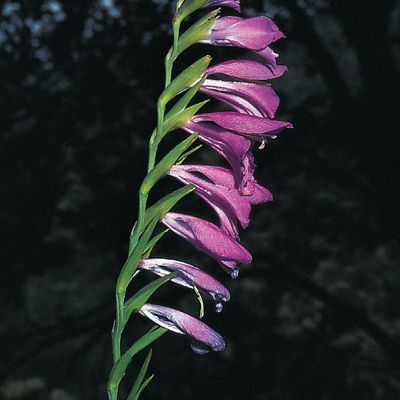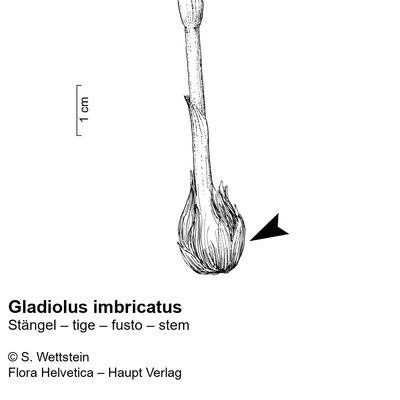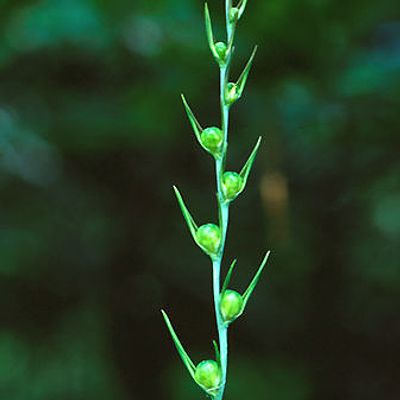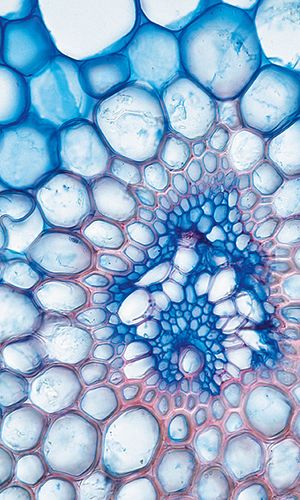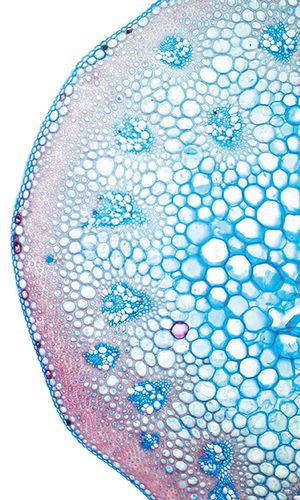Gladiolus imbricatus L.
1021630
Species
ISFS : 189900
Checklist : 1021630
ISFS : 189900
Checklist : 1021630
Contains :
Synthesis
Species description (© Flora Helvetica 2018)
Ähnlich wie G. palustris, aber Fasern der Knollenhülle +/- parallel laufend, sehr schmale Maschen bildend. Blätter 1-2 cm breit. Blütenstand gedrungen, 4-12blütig.Flowering period (© Flora Helvetica 2018)
7Habitat and distribution inside Switzerland (© Flora Helvetica 2018)
Trockene Wiesen, Gebüsche / montan / Südliches TIWorld distribution (© Flora Helvetica 2018)
OsteuropäischEcological indicator (© Landolt & al. 2010)
2+w+42-34+4.g.2n=14(60)Status
IUCN status
EndangeredNational Priority
2 - high national priorityInternational responsibility
2 - mediumConservation
Threats
Aufgabe der traditionellen Mähnutzung, Konkurrenz von Molinia arundinacea
Verbuschung, Beschattung
Beweidung
Weg-, Strassenbau, Unterhalt
Z. T. ungenügender Schutz, Sammeln
Kleine, isolierte Populationen
Anatomy
Summary of stem anatomy (German)
Umriss rund oder oval. Leitbündel in einer Reihe. Epidermiszellen nicht verholzt.Description
Culm-diameter 2-5 mm, center full, radius of culm in relation to wall thickness 1:1. Outline circular with a smooth surface. Culm-center full, containing unlignified cells. Culm without endodermis but with a sheath of lignified cells around the center. Epidermis cells thin-walled all around. Large vascular bundles arranged in 2-3 peripheral rows. Sclerenchyma belt in a large, peripheral continuous belt (> 3 cells). Cells thick-walled. Small sclerenchymatic sheath around vascular bundles with 1-2 cells. Vessel arrangement horseshoe-like. Largest vessel in the bundle 20-50 μm.Distribution map
Habitat and distribution inside Switzerland
Südliches TIWorld distribution
OsteuropäischEcology
Life form
Geophyte
Habitats
Milieux Phytosuisse (© Prunier et al. 2017)
Habitats © Delarze & al. 2015
 | 2.3.1 - Pfeifengraswiese (Molinion) |
bold
Dominant species, influencing the appearance of the habitat
 Character species
Character species
 Less strictly linked to a specific habitat
Less strictly linked to a specific habitat
Ecological indicator values by © Landolt & al. (2010)
| Soil factors | Climatic factors | Salinity tolerance | |||
|---|---|---|---|---|---|
| Humidity Value H | 2+w+ | Light Value L | 3 | Salinity Index | -- |
| Reaction Value R | 4 | Temperature factor T | 4+ | ||
| Nutriments value N | 2 | Continentality K | 4 | ||
- Ecological values legend
Humidity Value H 1 very dry 1+ dry 2 moderatly dry 2+ moist 3 medium wet 3+ wet 4 very wet 4+ soggy 5 submerged or underwater f plants living in running water u mostly submerged plants v partly submerged, partly floating plants w humidity moderately variable (± scale of 1-2) w+ highly variable humidity (scale exceeding ± 2) Reaction Value R 1 Very acid (pH 2.5-5.5) 2 acid (pH 3.5-6.5) 3 lightly acid to neutral (pH 4.5-7.5) 4 neutral to basic (pH 5.5-8.5) 5 basic (pH 6-5 -> 8.5 Nutriments value N 1 very low in nutrients 2 low in nutriments 3 medium-poor to medium-rich in nutrients 4 rich in nutriments 5 very rich in nutriments Salinity tolerance 1 halotolerant 3 halophyle Light Value L 1 very shady 2 shady 3 lighted areas 4 luminous 5 highly luminous Temperature factor T 1 alpine to nival stages (from the treeline to the snowline) 1+ suprasubalpine and upper subalpine levels (pine and larch forests) 2 subalpine level (coniferous forests without beeches up to the upper limit of spruces) 2+ lower subalpine and upper mountain stages 3 mountain level (beech and silver fir forests, in the central Alps Scots pine forests) 3+ lower mountain and upper hill levels 4 hill level (mixed deciduous oak forests) 4+ hot places, hill level 5 very hot places, hill level (only in the hottest places, typical of southern Europe) Continentality K 1 Atlantic (high air humidity, very low temperature variations, mild winters) 2 Sub-Atlantic (high air humidity, low temperature variations, relatively mild winters) 3 sub-Atlantic to subcontinental (average air humidity, moderately variable temperature, slightly low winter temperatures) 4 subcontinental (low air humidity, large temperature variations, rather cold winters) 5 continental (very low air humidity, very large temperature variations, cold winters)
Water dependency
| Rivers | 0 - No link |
| Calm water | 0 - No link |
| Ground water | 0 - No link |
Nomenclature
Accepted Name (Checklist 2017)
Gladiolus imbricatus L.
Vernacular name
Deutscher Name :
Busch-Gladiole, Busch-SiegwurzNom français :
Glaïeul imbriquéNome italiano :
Gladiolo piemonteseMatch with other reference books
| Relation | Nom | Book | No |
|---|---|---|---|
| = | Gladiolus imbricatus L. | Checklist 2017 | 189900 |
| = | Gladiolus imbricatus L. | Flora Helvetica 2001 | 2919 |
| = | Gladiolus imbricatus L. | Flora Helvetica 2012 | 2503 |
| = | Gladiolus imbricatus L. | Flora Helvetica 2018 | 2503 |
| = | Gladiolus imbricatus L. | Index synonymique 1996 | 189900 |
| = | Gladiolus imbricatus L. | Landolt 1977 | 716 |
| = | Gladiolus imbricatus L. | Landolt 1991 | 623 |
| = | Gladiolus imbricatus L. | SISF/ISFS 2 | 189900 |
| = | Gladiolus imbricatus L. | Welten & Sutter 1982 | 2133 |
= The taxon corresponds to the accepted taxon (Checklist 2017)
< The taxon is included in the accepted taxon (Checklist 2017)
> The taxon includes (among others) also the accepted taxon (Checklist 2017)
< The taxon is included in the accepted taxon (Checklist 2017)
> The taxon includes (among others) also the accepted taxon (Checklist 2017)
Status
Native status
-IUCN list of endangered species (© Walter & Gillett 1997) : No
Status on national Red List 2016
IUCN status:
Endangered

Additional information
IUCN criteria: B2ab(iii); C2a(i)
Status on regional Red List 2019
| Biogregraphic regions | Status | IUCN criteria |
|---|---|---|
| Jura (JU) | -- | |
| Mittelland (MP) | -- | |
| Alpennordflanke (NA) | -- | |
| Alpensüdflanke (SA) | EN | B2ab(iii); C2a(i) |
| Östliche Zentralalpen (EA) | -- | |
| Westliche Zentralalpen (WA) | -- |
- Legend
EX Extinct RE Regionally Extinct CR(PE) Critically Endangered, Probably Extinct CR Critically Endangered EN Endangered VU Vulnerable NT Near Threatened LC Least Concern DD Data Deficient NE Not Evaluated NA Not Applicable
National Priority Species List Status
| National Priority | 2 - high national priority |
| Need to take action | 2 - |
| International responsibility | 2 - medium |
| Need to monitor populations | 2 - |
Protection status
| International (Bern Convention) | No | |
| TI | total protection | (23.01.2013) |
| Switzerland | total protection |
- Disclaimer
InfoFlora compiles information on protected species as accurately as possible, taking it from the respective cantonal laws. In some cases, however, it was not possible to use the plant names as listed in the original text, but an interpretation of their taxonomy or nomenclature was necessary. The exact meaning of the categories „completely protected“ and „partially protected“ differs among the cantons.
InfoFlora cannot guarantee that the information on the protection status is correct and complete. In case of doubts, we recommend to look up the texts of the respective cantonal law.
Status by sector of activity
| Agriculture-related environmental objectives : | Z - | more informations |
| Forest management environmental objectives : | more informations |
Conservation
Threats and measures
Aufgabe der traditionellen Mähnutzung, Konkurrenz von Molinia arundinacea
Bewirtschaftungsverträge
noch bestehende Mähnutzung unbedingt erhalten, Bestände sonst durch Pflegemassnahmen offenhalten (wie z. B. bei Cassina)
alle 2-3 Jahre im Herbst mähen
Mähgut wegnehmen
kein Abbrennen der Vegetation oder entfernen der Streu mit Rechen
Verbuschung, Beschattung
Entbuschen und an einigen Fundstellen
auslichten der feuchten Waldwiesen
Beweidung
Falls möglich Beweidung durch Wiesennutzung ersetzen
ansonsten nur angepasste, kontrollierte Beweidung und Bestand evtl. einzäunen (dann von Hand mähen, 1x jährlich)
Weg-, Strassenbau, Unterhalt
Auf Fundstellen Rücksicht nehmen
Z. T. ungenügender Schutz, Sammeln
Schutz der Parzellen (Ortsplanung oder private Schutzgebiete) z. B. am Monte San Giorgio verstärken, weiterhin gepflegte Naturschutzgebiete haben hier hohe Priorität (z. B. kommt auch Adenophora liliifolia vor)
zusätzliche Hinweisschilder zu Pflückverbot aufstellen
Kleine, isolierte Populationen
Ex situ-Vermehrung von Material aller Fundbereiche
evtl. später Wiederansiedlung
regelmässige Bestandeskontrollen
Detailkartierungen
erneute Suche bei «Pianche» ob Rovio
Erfolgskontrollen der Massnahmen gewährleisten
